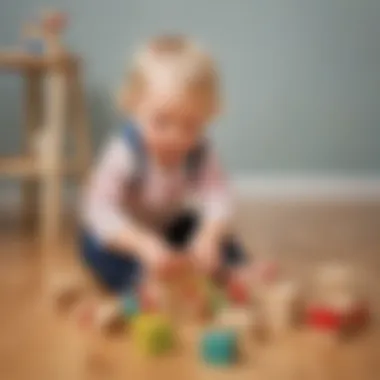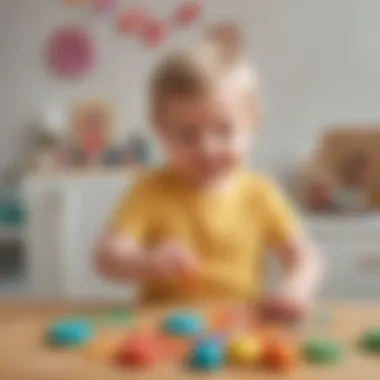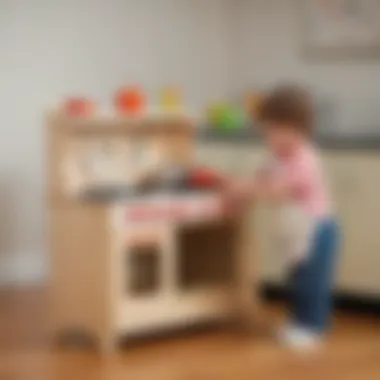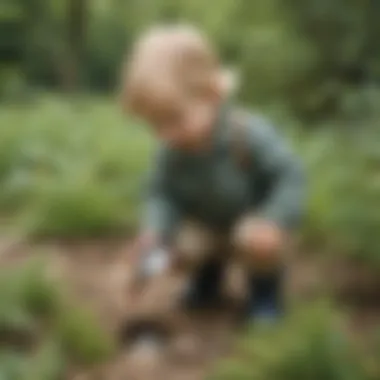Discovering the Fascinating Play Choices of Two-Year-Olds


Fun Activities Ideas
Two-year-olds are in a critical stage of development where play is not just a form of entertainment but also a vital means of learning and exploration. Parents, caregivers, and educators play a significant role in providing enriching play experiences that cater to the play preferences of these young minds. Let's delve into various fun activities that capture the attention and imagination of two-year-olds.
Indoor Activities
Indoor activities offer a safe and stimulating environment for two-year-olds to engage their senses and foster their creativity. From building forts with cushions and blankets to creating sensory bins filled with different textures like rice, beans, or water beads, indoor play allows for imaginative exploration right at home. Setting up a mini obstacle course using pillows, tunnels, and toys can promote gross motor skills while playing with puppets or engaging in pretend play nurtures social and language development.
Outdoor Adventures
Venturing outside opens up a world of possibilities for two-year-olds to experience nature, fresh air, and physical activity. Simple outdoor adventures like going to the park to swing, slide, or explore the sandbox can provide sensory stimulation and promote physical coordination. Nature walks or visits to the zoo offer opportunities to learn about different animals, plants, and the natural world. Engaging in water play with sprinklers or small pools can encourage experimentation and discovery while fostering a love for the outdoors.
Arts and Crafts
Arts and crafts activities unleash the creativity of two-year-olds, allowing them to express themselves through colors, shapes, and textures. Finger painting, drawing with chalk, or creating collages using a variety of materials help develop fine motor skills and artistic abilities. Crafting with simple supplies like paper plates, glue, and stickers can spark imaginative play and provide a sense of accomplishment upon completion. Engaging in imaginative play through role-playing with homemade costumes or puppets enhances storytelling skills and encourages self-expression.
Science Experiments
Introducing simple science experiments to two-year-olds fosters a sense of wonder and curiosity about the world around them. Activities such as making homemade playdough to explore textures, colors, and mixing ingredients provide a hands-on approach to learning basic scientific concepts. Creating a baking soda and vinegar volcano or observing a plant grow from a seed cultivates a fascination for cause and effect relationships and encourages critical thinking skills. Exploring sensory bottles filled with glitter, water, and oil stimulates visual and tactile senses, promoting sensory development and exploration.
Cooking and Baking
Involving two-year-olds in cooking and baking activities not only enhances their motor skills but also fosters a sense of independence and accomplishment. Simple tasks like stirring ingredients, pouring liquids, or arranging toppings on pizza engage children in the cooking process and promote a sense of responsibility. Baking cookies or muffins together provides opportunities for sensory exploration through touching, tasting, and smelling ingredients while introducing basic math concepts like measuring and counting. Cooking with two-year-olds not only introduces them to different foods and flavors but also cultivates a lifelong love for cooking and family bonding.
Introduction
Understanding the Playful Minds
Cognitive Development
Cognitive development is a fundamental aspect of a child's growth, encompassing the processes of thinking, learning, and problem-solving. In the context of this article, cognitive development plays a crucial role in shaping the play preferences of two-year-olds. Understanding the key characteristic of cognitive development in toddlers sheds light on their ability to explore, discover, and make sense of the world around them. While cognitive development is a popular choice for discussion in this article due to its significant impact on children's overall development, it also presents challenges such as information processing limitations that can affect their play experiences.
Emotional Expression
Emotional expression plays a vital role in showcasing children's feelings, desires, and responses during play. Exploring emotional expression within the realm of play preferences provides insights into how two-year-olds engage with their surroundings and interact with various stimuli. The key characteristic of emotional expression lies in its ability to convey inner emotions and responses through actions and behaviors. While emotional expression is a popular topic for this article due to its profound influence on children's social and emotional development, it may present challenges such as difficulty in regulating emotions effectively during play.
Social Interaction
Social interaction forms the foundation of children's communication, relationship-building, and the development of social skills. Within the context of this article, understanding the importance of social interaction in shaping play preferences offers valuable insights into how two-year-olds engage with peers, adults, and the environment. The key characteristic of social interaction lies in its role in fostering collaboration, empathy, and language development during play activities. Although social interaction is a beneficial choice for discussion in this article due to its impact on children's socialization, it may present challenges such as conflicts or difficulties in sharing and taking turns during play.
Significance of Play in Early Childhood
Learning Through Play


Learning through play underscores the idea that children acquire knowledge, skills, and understanding through hands-on experiences and exploration. Exploring the significance of learning through play in early childhood sheds light on how play activities can stimulate cognitive, physical, and emotional development in toddlers. The key characteristic of learning through play is its ability to make learning enjoyable, engaging, and meaningful for young children. While learning through play is a popular choice for discussion in this article due to its holistic approach to education, it may present challenges such as ensuring that play activities align with educational goals and objectives.
Developmental Milestones
Developmental milestones mark the important achievements and abilities that children attain at different stages of their growth and development. Discussing developmental milestones within the context of play preferences provides valuable insights into the age-appropriate skills and behaviors that two-year-olds exhibit during play. The key characteristic of developmental milestones is their role in tracking and monitoring children's progress across various areas of development such as motor skills, language, and social interactions. Although developmental milestones are a beneficial choice for discussion in this article due to their relevance to assessing children's development, they may present challenges such as variations in individual timelines and expectations.
Bonding and Communication
Bonding and communication are essential elements that strengthen relationships, foster positive connections, and support children's emotional well-being. Exploring the significance of bonding and communication in early childhood play experiences highlights the importance of creating secure attachments and meaningful interactions for young children. The key characteristic of bonding and communication lies in their ability to enhance trust, empathy, and understanding between children and their caregivers. While bonding and communication are popular topics for discussion in this article due to their impact on building strong relationships, they may present challenges such as establishing effective communication strategies and maintaining consistent interactions.
Sensory Exploration
Sensory exploration plays a pivotal role in the holistic development of two-year-olds. This section delves into the significance of sensory stimulation in fostering cognitive abilities, emotional regulation, and social interactions. By engaging in sensory activities, children enhance their sensory processing skills, learn about their environment, and develop crucial cognitive connections.
Tactile Sensory Play
Textures and Fabrics
Textures and fabrics offer a tactile experience that aids in sensory exploration. The differing textures such as smooth, rough, or fuzzy engage children's senses, encouraging them to touch, feel, and explore various materials. This hands-on exploration not only stimulates their sense of touch but also promotes sensory integration and fine motor skills development. Textures and fabrics are a popular choice for sensory play due to their versatility and ability to engage children in sensory-rich experiences.
Sensory Bins
Sensory bins involve the use of different materials like rice, pasta, or sensory beads, providing a multi-sensory experience for young children. The bins offer a contained space for exploration where kids can dig, pour, and scoop, enhancing their tactile and visual sensory skills. This hands-on play promotes sensory exploration and creative thinking while also fostering language and cognitive development. Sensory bins are favored for their capacity to offer open-ended play opportunities and sensory engagement.
Visual Stimulation
Visual stimulation is vital for promoting two-year-olds' cognitive and perceptual development. This section explores the use of visual stimuli like colorful flashcards and shape sorters to engage children's visual senses and enhance their cognitive abilities.
Colorful Flashcards
Colorful flashcards are effective tools for visual stimulation and learning. The vibrant colors and engaging images capture children's attention, aiding in visual discrimination and object recognition. Flashcards provide a visually stimulating way to introduce new concepts, shapes, colors, and objects to toddlers, promoting language development and cognitive skills. Their portability and versatility make them a popular choice for on-the-go learning and interactive play.
Shape Sorters
Shape sorters are educational toys that facilitate shape recognition and fine motor skills development in young children. By matching different shapes to corresponding slots, kids enhance their visual-spatial awareness and problem-solving abilities. The engaging nature of shape sorters encourages hands-on learning and cognitive development, making them a valuable resource for early childhood education. Their durability and educational benefits make shape sorters a preferred choice for parents and educators.
Auditory Discoveries
Auditory discoveries involve exploring sounds and music through musical instruments and sound books, promoting the development of auditory discrimination and sound recognition skills.
Musical Instruments
Musical instruments offer children the opportunity to create and explore different sounds, rhythms, and melodies. Playing musical instruments enhances auditory processing skills, fine motor coordination, and creativity. The exposure to various musical tones and patterns contributes to children's cognitive and emotional development, fostering a love for music and stimulating their auditory senses. The versatility and educational value of musical instruments make them an enriching choice for introducing young children to the world of music.


Sound Books
Sound books combine visuals with audio elements, providing interactive auditory experiences for children. These books engage multiple senses, allowing kids to listen to sounds while associating them with corresponding images. Sound books enhance language development, auditory discrimination, and listening skills in young learners. The interactive nature of sound books captivates children's attention, making learning enjoyable and immersive. Their interactive features and educational benefits make sound books a popular choice for early childhood literacy and language development.
Interactive Play
Pretend Play
Dress-Up Costumes
Dress-Up Costumes play a significant role in fostering creativity and imaginative thinking among two-year-olds. These costumes enable children to role-play different characters, exploring various roles and scenarios, which in turn enhances their cognitive development. The key characteristic of Dress-Up Costumes lies in their ability to transport children to different worlds, sparking their curiosity and expanding their pretend play scenarios. The unique feature of Dress-Up Costumes is their versatility; children can embody different roles and personas, fostering empathy and emotional expression. While Dress-Up Costumes provide a gateway to imaginative storytelling and social play, it is essential to ensure that the costumes are age-appropriate, safe, and comfortable for young children.
Toy Kitchen Sets
Toy Kitchen Sets contribute significantly to Interactive Play by offering children a platform to engage in role-play activities related to food preparation and cooking. The key characteristic of Toy Kitchen Sets is their ability to mimic real-life kitchen scenarios, allowing children to imitate adult behaviors and explore various food-related interactions. This imaginative play fosters socio-emotional development as children learn to cooperate, communicate, and share while engaging with others in a pretend kitchen setting. The unique feature of Toy Kitchen Sets is their capacity to enhance fine motor skills through activities like cutting, stirring, and serving, promoting hand-eye coordination and dexterity. While Toy Kitchen Sets offer a wealth of pretend play opportunities, it is essential to choose sets that are durable, safe, and conducive to collaborative play.
Building and Construction
Building Blocks
Building Blocks are fundamental to nurturing spatial awareness, problem-solving, and creativity in two-year-olds. The key characteristic of Building Blocks is their versatility and interlocking design, allowing children to construct various structures and shapes, stimulating their spatial reasoning and fine motor skills. These blocks lay the foundation for understanding concepts like balance, stability, and symmetry, fostering cognitive development and logical thinking. The unique feature of Building Blocks is their open-ended nature, empowering children to experiment, innovate, and explore endless construction possibilities. While Building Blocks promote constructive play and critical thinking, it is essential to choose blocks of appropriate size, material, and complexity to ensure engagement and safety for young builders.
Stacking Cups
Stacking Cups offer young children a tactile and visual exploration of spatial relationships, sizes, and patterns. The key characteristic of Stacking Cups lies in their nesting design, allowing children to stack, nest, and sequence cups in various ways, developing their understanding of volume, concepts of big and small, and hand-eye coordination. These cups facilitate sensory exploration, as children engage in activities like pouring, filling, and stacking, enhancing their fine motor skills and sensory perception. The unique feature of Stacking Cups is their multi-functional use; children can engage in water play, sand play, or indoor stacking games, fostering creativity and experimentation. While Stacking Cups provide versatile play opportunities, it is essential to ensure the cups are made of safe, non-toxic materials and are easy to clean for hygienic play experiences.
Puzzles and Shape Sorters
Chunky Wooden Puzzles
Chunky Wooden Puzzles offer tactile and cognitive challenges that promote problem-solving, hand-eye coordination, and shape recognition in two-year-olds. The key characteristic of Chunky Wooden Puzzles is their chunky pieces and vibrant illustrations, making them engaging and accessible for young children to grasp and manipulate. These puzzles enhance spatial awareness, logic, and perseverance as children navigate fitting shapes into corresponding spaces, building confidence and persistence. The unique feature of Chunky Wooden Puzzles is their durability and sensory appeal, providing a tactile experience that stimulates sensory exploration and fine motor skills. While Chunky Wooden Puzzles offer cognitive benefits and quiet play opportunities, it is essential to introduce puzzles with age-appropriate complexity and themes that align with children's interests and abilities.
Shape Sorting Cubes
Shape Sorting Cubes introduce children to basic shapes, colors, and spatial reasoning through interactive play experiences. The key characteristic of Shape Sorting Cubes is their diverse shapes and slots that challenge children to match shapes correctly, developing their problem-solving skills and visual discrimination. These cubes stimulate hand-eye coordination, concentration, and perseverance as children manipulate shapes to fit into corresponding holes, fostering cognitive development and attention to detail. The unique feature of Shape Sorting Cubes is their versatile play options, allowing children to engage in color sorting, shape recognition, and stacking activities, promoting comprehensive skill development. While Shape Sorting Cubes provide hands-on learning opportunities, it is essential to guide children through initial challenges, offer encouragement, and ensure a safe play environment to maximize learning and engagement.
Outdoor Adventures
In the realm of play preferences for two-year-olds, Outdoor Adventures stand out as a pivotal element in providing a well-rounded and enriching play experience. Outdoor activities offer a tangible connection to nature and the world around them, fostering a sense of exploration and discovery. The importance of Outdoor Adventures in this article lies in their ability to spark curiosity, promote physical activity, and encourage a deeper appreciation for the environment.
Exploration in Nature
Nature Walks


Nature Walks present a cornerstone in the Outdoor Adventures section, emphasizing the significance of immersing two-year-olds in the wonders of the natural world. The distinct allure of Nature Walks lies in their ability to stimulate all the senses simultaneously, from feeling the texture of leaves to hearing the birds chirping. This hands-on experience not only enhances sensory development but also instills a love for nature at an early age. While Nature Walks offer abundant benefits in terms of promoting environmental consciousness and physical well-being, their main drawback may be the need for cautious supervision due to potential hazards.
Sand and Water Play
On the other hand, Sand and Water Play introduce a different dimension to Outdoor Adventures by offering tactile experiences that are both stimulating and engaging. The main characteristic of Sand and Water Play is the open-ended nature of these activities, allowing children to explore and experiment freely. This freedom not only enhances creativity but also improves fine motor skills through activities like pouring, scooping, and molding. The versatility of Sand and Water Play makes it a popular choice for this article, as it encourages sensory exploration and imaginative play. However, one consideration to keep in mind is the mess factor associated with these activities, requiring designated play areas for cleanup ease.
Ride-On Toys
Moving on to Ride-On Toys, they play a crucial role in promoting physical development and coordination skills in two-year-olds. Mini Tricycles, for instance, offer a unique aspect of independence and mobility, allowing children to navigate their surroundings with a sense of control. The key characteristic of Mini Tricycles is their ability to promote balance and spatial awareness while providing a fun and engaging way to stay active. Their popularity in this article stems from the dual benefits of physical exercise and entertainment they offer. Despite these advantages, proper supervision is essential to ensure safety during play.
Push Cars
Conversely, Push Cars offer a different experience by focusing on pushing and steering movements, enhancing both gross and fine motor skills. The key characteristic of Push Cars is their simplicity, making them easy for young children to operate while also promoting independence and confidence. The appeal of Push Cars in this article lies in their versatility, as they can be used both indoors and outdoors, providing year-round enjoyment. However, one drawback to consider is the limited developmental stimulation compared to other Ride-On Toys like tricycles.
Ball Play
Lastly, Ball Play introduces two variations, Soft Balls and Inflatable Beach Balls, each offering distinct benefits to two-year-olds' play preferences. Soft Balls cater to indoor and outdoor play, promoting hand-eye coordination and gross motor skills. Their soft texture ensures safe play, making them a popular choice in this article for their role in physical development and social interaction. On the other hand, Inflatable Beach Balls bring a sense of joy and excitement to outdoor play, encouraging movement and cooperative play. Their lightweight and vibrant colors make them visually appealing and versatile for various activities. While Soft Balls offer safety and skill development, the drawback may be limited sensory engagement compared to more textured toys. On the contrary, Inflatable Beach Balls may require inflation maintenance and storage considerations in the context of this article.
Creative Expression
Creative expression plays a pivotal role in the holistic development of two-year-olds, fostering their artistic abilities and unleashing their imagination. In this article, Creative Expression serves as a crucial topic that caters to the artistic inclinations of young children, promoting self-expression and creativity. It is an essential aspect of early childhood education, allowing children to explore various forms of art and sensory experiences that contribute to their cognitive and emotional growth.
Artistic Endeavors
Finger Painting
Finger Painting is a fundamental artistic activity that holds immense value in shaping a child's sensory and motor skills. This tactile form of art provides children with a hands-on experience to express their emotions and ideas through colorful strokes. The key characteristic of Finger Painting lies in its messiness, encouraging children to explore textures and colors freely. It is a popular choice in early childhood education due to its simplicity and ability to stimulate creativity. The unique feature of Finger Painting is its ability to engage all the senses simultaneously, making it a highly enriching experience for two-year-olds.
Playdough Sculpting
Playdough Sculpting involves molding and shaping pliable dough to create various forms and figures, enhancing a child's fine motor skills and creativity. This hands-on activity allows children to manipulate the dough, promoting hand-eye coordination and sensory exploration. The key characteristic of Playdough Sculpting is its versatility, enabling children to experiment with different shapes and textures. It is a beneficial choice for this article as it encourages imaginative play and sensory development. The unique feature of Playdough Sculpting is its ability to promote problem-solving skills, as children explore different ways to mold the dough.
Music and Movement
Dance Parties
Dance Parties offer a fun and interactive way for two-year-olds to engage in physical activity and express themselves through movement. This lively activity allows children to groove to music, promoting coordination and rhythm. The key characteristic of Dance Parties is their ability to encourage social interaction and cognitive development. It is a popular choice for this article as it combines physical exercise with creative expression, fostering a holistic approach to play. The unique feature of Dance Parties is their role in boosting confidence and self-esteem in children as they showcase their moves.
Sensory Dancing
Sensory Dancing involves incorporating sensory elements into dance routines, engaging multiple senses and enhancing the sensory experience for children. This multisensory activity promotes body awareness and coordination while stimulating the imagination. The key characteristic of Sensory Dancing is its ability to create a stimulating environment for children to explore movement and music. It is a beneficial choice for this article as it caters to a two-year-old's need for sensory stimulation and creative expression. The unique feature of Sensory Dancing is its ability to integrate sensory props like scarves or ribbons, adding an extra dimension to the dance experience.
Storytelling and Puppetry
Picture Books
Picture Books offer a gateway to imagination and storytelling, captivating two-year-olds with vivid illustrations and engaging narratives. This form of storytelling enhances language development and nurtures a love for reading from a young age. The key characteristic of Picture Books is their ability to transport children to different worlds through visual storytelling. Picture Books are a popular choice for this article as they foster a love for literature and encourage literacy skills. The unique feature of Picture Books is their interactive nature, allowing children to engage with the story through visuals and narration.
Hand Puppets
Hand Puppets add a magical element to storytelling, allowing children to bring characters to life and engage in imaginative play. These puppets spark creativity and assist in language development as children interact with the puppet characters. The key characteristic of Hand Puppets is their ability to facilitate role-playing and creative expression. Hand Puppets are a beneficial choice for this article as they promote social skills and communication through puppet interactions. The unique feature of Hand Puppets is their adaptability, enabling children to create stories and scenarios using the puppets as characters.



